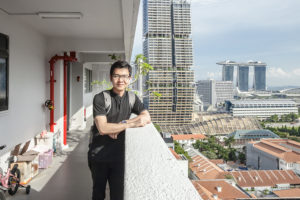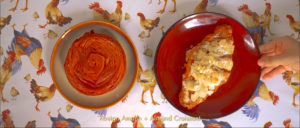Singapore’s answer to Wes Anderson is back to highlight the cityscape’s visual pizzazz in more stylish videos inspired by the American filmmaker’s unique art direction.
Just a month after releasing a very dreamy video of a pastel-hued tour of Singapore, architectural photographer Kevin Siyuan is back with a new captivating tour focused on specific neighborhoods, starting with the very hip Tiong Bahru. His latest video is a five-minute whimsical journey through nostalgic, pre-war apartments and charming cafes.
“I think this film series can be further explored. I don’t see a lot of filmmakers paying more attention to architecture and Wes Anderson is the most prominent figure I noticed. I just want to do my part in showcasing Singapore in an artistic manner, combining architectural and filmmaking,” he told Coconuts.
Read: Photographer gives Singapore the Wes Anderson treatment (Video)
A Wes Anderson-ish Trip Around Tiong Bahru also features murals, hawker fare and even an exclusive tour inside an air raid shelter. The project, which he began as soon as the pilot was out, took a month to complete.
In a wide-ranging interview about his life and unique obsession, we discovered 10 things. His responses were lightly edited for clarity and space.

1. He is an ‘Accidental Wes Anderson’ fan
Surprisingly, Kevin had never really heard of Anderson until photos of his Singapore corridor project were posted to the Accidental Wes Anderson thread on Reddit and he was introduced to The Grand Budapest Hotel by his wife. The thread, which has 350,000 members, shares pictures and videos that resemble the style of the American film director. The corridor project was subsequently turned into a short film in 2019.
“I noticed someone posted the corridor project on the Accidental Wes Anderson subreddit and back then my wife introduced The Grand Budapest Hotel to me then I have this idea of turning all the still pictures I took of the corridors into a short film using the kind of composition that is also shared in a Wes Anderson type of film,” Kevin said.
2. Favorite Wes Anderson films
Kevin is a big fan of Anderson’s 2014 film The Grand Budapest Hotel and noted that not many film directors focus on architecture except as much as Anderson does.
“I was mesmerized by the colors and how he made architecture an integral part of the visual narrative, his symmetrical shots are eye opening to me as well, at that time I never imagined movie scenes could be shot so precisely and meticulously,” he said.
“As an architectural photographer, the kind of symmetrical shots he used, the pastel colors, its something I got a lot of inspiration from which is why I also find myself drawn to his style so I feel like I can try to explore this field by doing a series of videos in the Singapore context,” he added.
3. It all started with corridors
Kevin’s big break as an architectural photographer came in 2017 when he published a series of stills of Singapore’s housing corridors on ArchDaily, comparing the isolated contemporary variety to those more openly built in the ‘60s. The old corridors still exist today in Hougang, Toa Payoh and Jurong.
“It all started off from the corridor project. The views of the slab block corridors actually offer quite an interesting perspective that you can explore in terms of seeing the urban landscape of Singapore. That’s how I can best showcase the urban planning elements visually in photographs,” he said.

4. He loves Tiong Bahru
The second instalment of the Wes Anderson-ish Trip series focuses on the Tiong Bahru estate, which Kevin considers as a “good example” of Singapore’s kampong spirit.
“I always wanted to do something about Tiong Bahru. It’s the first [Singapore Improvement Trust] neighborhood with quite a bit of history and the flats are also aesthetically designed. There’s a lot of interesting elements that fit symmetrical shots and the neighborhood itself is quite charming with a lot of elements to feature besides architecture, there’s also hawker food,” he said.
5. Goats make him smile
A goat family mural shot featured in Kevin’s Tiong Bahru episode is his favorite. The scene involves a fast-forward pan through a corridor toward the mirror, one of three goat murals plastered around the neighborhood by Singaporean artist Ernest Goh.
“Besides the ‘Centre Divide’ composition, one of the techniques I like to use in my videos is the forward dashing shot. I am very happy how this shot turned out, the leading lines visual impact is pretty cool and to me, it’s pretty humorous,” he said.
6. He travels light
Unlike a big budget Wes Anderson film set, Kevin only packs a Sony camera and sometimes a GoPro on a shoot. He relies on his camera’s auto stabilize functions and post-processing to get clutch shots.
“I am using an all-around lens and a GoPro when needed. The lens scope is sufficient for me, sometimes I need the zoom more than the wide angle as it allows me to compose frames that are neater with less unwanted elements. I can get by by adjusting my position or zoom, and I could focus more on capturing moments without the additional concerns of switching lenses,” he said.
7. Not only Anderson
Besides Wes Anderson, Kevin considers Japanese directors Takeshi Kitano and Hayao Miyazaki, alongside Korean director Bong Joon-ho as inspirations. He names some of his favorite films like Kitano’s 90s’ dramas Kikujiro and Hanabi, and Bong Joon-ho’s 2019 thriller Parasite.
“I got inspired by Takeshi Kitano, mainly the films Kikujiro and Hanabi. His style is making very long still shots, where one person just stands still and does nothing. I also like Hayao Miyazaki for his bright colours and compositions, and Bong Joon-ho, for his interesting usage of architecture in Parasite,” he said.
8. The WWII shelter was most challenging to shoot
The Tiong Bahru Air Raid Shelter, which used to shelter close to 2,000 residents when the Japanese forces conducted air raids during World War II, was the most challenging shot Kevin had to pull given the dark cramped space and the “slightly complicated” process of obtaining permission from the town council and media authority to film inside.
“The Air Shelter is a rather confined space indoors, and the lighting conditions inside aren’t great. Because of the low light, I couldn’t use the GoPro as it would compromise image quality, so I mounted my camera on a gimbal instead and took quite a few takes per scene to ensure I got the shots I wanted,” he said.

9. The Singapore Town episode was inspired by a National Day song
Initially, the first episode of the Wes Anderson-ish Trip series was going to focus solely on new developments but Kevin switched it up to loosely follow the 1997 National Day anthem Singapore Town which featured notable landmarks like Collyer Quay and Raffles Place.
“At first, I just want to make a montage showing the new architectures of Singapore but I was thinking of some places like Esplanade and Raffles City which also came from the lyrics of a song we used to listen during our childhood so I decided to make it more to the local context,” he said.

10. More videos in the pipeline
Kevin teased that there will be a few more episodes in the series focusing on different aspects of Singapore. For example, he wants to cover Little India in the style of Anderson’s 2007 film The Darjeeling Limited, which was shot in India, and feature boy scouts similar to the 2012 coming-of-age film Moonrise Kingdom.
“I want to feature some garden city elements of Singapore like parks and nature reserves then the final episode will be the heartlands with HDB flats, community, town centers, new towns, mix people and architecture,” he said.
“I realized just to feature architecture may be a bit boring after watching for a while. Having people, culture and food element definitely will make the project more interesting,” he added.

Other stories you should check out:
Photographer gives Singapore the Wes Anderson treatment (Video)
Watch Singapore rise and fall in athletic filmmaker’s 8-year time lapse





Reader Interactions